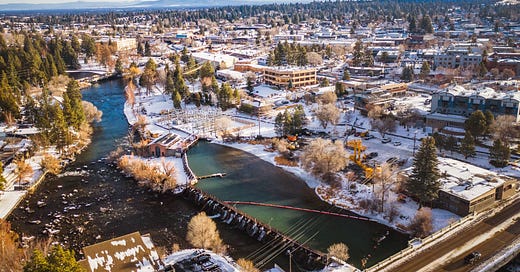The 2023 Legislative housing agenda - Was it enough?
Legislators approved a wide range of programs to address the housing crisis at different friction points, but buildable land could remain a problem
The 2023 session's clarion call for housing brought forth a variety of legislation that reflected the broad and deep housing needs of our state. It was an attempt to attack the issue on many fronts, but was it enough to get the housing production flywheel spinning? The Legislature's injection of $2.5 billion for Oregon Housing & Community Services (OHCS) was the most significant indication that the state is serious in its attempt to put us on a path toward shoring up our state’s housing crisis.
The success of this session's legislation will play out differently across the state. Where I work in Central Oregon, we are 11,000 homes short of our current need, and the number of unhoused people is growing fast. Although we will see visible benefits, the path to a stable housing inventory will take years of investment.
It will also require additional buildable land—something Gov. Kotek and many communities in Oregon were counting on through HB 3414. It was supposed to alleviate the need for more buildable land to meet housing projections by allowing cities modest annexations of urban reserves but failed to pass the Senate the last day of session. We hope this is addressed in the next session.
Still, the 2023 session will undeniably get us moving in the right direction for all kinds of housing, including our growing unhoused population. SB 5511 invests over $132 million in emergency and transitional housing to support the governor's emergency declaration on homelessness. This includes additional shelter beds, rehousing and navigation services, and other projects along the continuum of care.
Unhoused populations also benefited from the Affordable Housing and Emergency Homelessness Response Package, outlined in HB 2001 passed early this session. The package includes a $200 million investment to help shelter Oregonians living on the street, prevent more homelessness, and ramp up affordable housing production across the state. This session also delivered some innovative policies that open the door to creative solutions, including a $250,000 grant to HomeShare Oregon, a nonprofit that connects homeowners who have a spare bedroom to rent to seekers of affordable housing.
There was also funding for Oregonians who have a dream of home ownership. Nearly $10 million was set aside to help build attainable bridge financing for permits and other pre-development costs to lower the overall cost of the home. The legislature went further to address one of the largest obstacles: high down payments, including $7.5 million for down payment assistance. In Bend, only 8 percent of the population can afford to purchase a home mainly due to the high cost of down payments. This type of funding can have a profound benefit for thousands of people who could make monthly mortgage payments but have no hope of accumulating what is needed for a down payment.
This year's legislation also invested in creative housing models. For example, Central Oregon launched new projects this year on deed-restricted property that provide subsidized, low-cost homes that can only be sold to local workers. This type of model could be replicated through SB 5511, which provides $20 million for the development of alternative homeownership models, including co-ops and community land trusts, and another $20 million in bonds for home ownership. These projects can leverage more funding from non-profits and the private sector to bring home ownership to even more Oregonians.
Local governments now have a new tool in their toolbox with SB 919, which allows for a five-year property tax exemption for newly constructed middle housing units occupied as a primary residence. This means a break on property taxes for creating density via duplexes, ADUs, and other types of "middle housing.”
Many funding decisions were made in the waning days of the 2023 session as legislators combined budget priorities and state bonding authority into omnibus bills, including appropriating $600 million for the acquisition and construction of affordable housing, including Federally subsidized housing. This funding is projected to incentivize the construction of almost 3,000 rental units and more than 380 homes.
This year's legislation will have impacts that are widespread. It may not result in the Governor's goal of 36,000 housing units per year, but it will hopefully be enough to see real progress.
Katy Brooks is the Bend Chamber of Commerce CEO. Katy is a member of the Oregon State Early Learning Council and has served on numerous regional, state and city boards and committees. Prior to coming to Bend, Katy was the economic development director for the Port of Vancouver and served on the board of directors for the Washington State Business Association.






Great summary! But an important note: there's a big difference between "raw supply of land" and "buildable land." The concept outlined in HB 3414 doesn't add buildable land; it adds raw supply of land, something we are not lacking. For example, in 2016, Bend added 2,380 acres in ten different expansion areas to its urban growth boundary (aka added raw supply of land). Over the past six years, less than 10% of the total possible housing has been built in these expansion areas.
Adding the raw supply of land outlined in HB 3414 won't do anything for our housing crisis and it may even put a strain on local resources and ignore important factors like wildfire risk or water supply. The most direct path to addressing our housing affordability and availability crisis must focus on solutions that turn our existing supply of raw land into buildable land.